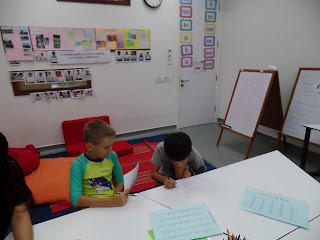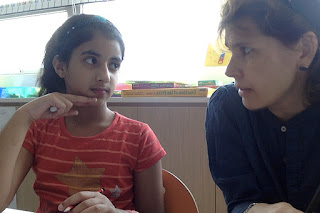This week my Grade 2 students were busy reading more about simple machines and doing experiments.
All the children were really engaged in the experiments. They made their discoveries and shared their findings with their peers. They also had a chance to share their learning with each other.
 |
| Visal and Jayden were learning about the weight arm and force arm using a ruler and a bean bag. |
 |
| Samir, Kim Veng and Sorriaj were learning about forces. |
It was a parallel teaching session and it gave the classroom teachers and me a chance to work on our team skills. At the beginning our students had to decide who will do what and choose the parts. It became obvious who learned to compromise and who still needs to practice. After sorting out the parts the players had to read the parts and think creatively about acting out certain moments. During this activity the children had a chance to lead if they had a valuable idea and to follow when it was time to agree with their peers. It was exciting to observe the ELLs as they were all very enthusiastic about participating in the play but chose the shorter parts.
In each classroom I worked with two groups and both groups had enough time to practice the play and then presented to the other group. The change of the roles was useful, as while being part of the audience, students were able to provide much needed feedback to the other group. It helped our learning process and we practiced speaking and expressive skills, listening and critical thinking skills, communication skills in general and team building skills. Great learning experience in one session!
 |
| Miss Lisa's girls were led by Monica and everyone enjoyed practicing. |
 |
| Oceana and Olivia were the stars as always. |
In order to support the learning that took place in class I thought it was important to focus on listening and speaking skills in my EFL classes. With my Grade 2 students we read comprehension texts about simple machines and completed listening cloze activities. At the end of the week we created a mini book about simple machines and had to write a blurb about the author on the back of the cover.
 |
| Samir is proud of his mini book! |
 |
| Mollymoon enjoyed creating her book. |
EAL BEGINNERS
It was a productive week for my beginners group where we continued our guided reading sessions and had meaningful discussions of the author's message and the moral of the story. The stories that we are reading are easy ones, however, it was a bit challenging for my EAL beginners to unpack the message and say what they learned from the stories.
 |
| The story abut Morty the bear taught us to be happy with what we have. |
We talked about interesting facts and important facts and tried to memorize important facts to teach our friends and maybe even parents. Do you know the difference between a crocodile and an alligator or a turtle and a tortoise? Ask Jade, Yubin, Sofia or Thomas and they will teach you!

























